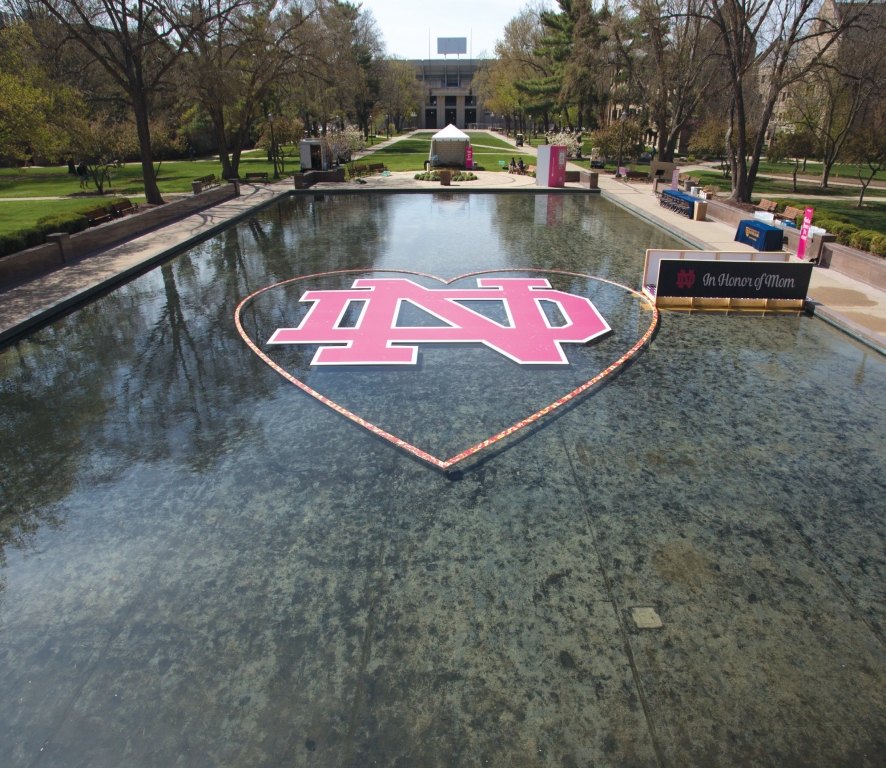In 1904, Univ. of Notre Dame (ND) alum Frank Hering (the “father” of Mother’s Day) began lobbying for a national holiday to honor mothers. He was inspired by an ND professor whose classroom assignment involved students writing penny cards for their mothers. President Woodrow Wilson officially made Mother’s Day a national holiday in 1914.
This year, which marks the 101st anniversary of the holiday, the ND Alumni Assn. decided to celebrate with a 41 x 50-ft., floating heart with an interlocking, 29 x 21-ft. ND logo, all of which would float in the 72 x 136-ft. Hesburgh Reflecting Pool on campus.
Enter Agio Imaging from the appropriately named city of Portage, MI. The company has provided signage for the university for a decade, beginning with a single, 40 x 10-ft. banner, and has since cultivated a full-service partnership. However, Agio hadn’t been asked to create a floating sign.
Consequently, this turnkey project included consulting, design and engineering services, printing and fabrication, custom milling, on-site assembly and installation. ND only provided the concept.
Agio experimented with Gatorplast® graphic display board (3A Composites, Statesville, NC). A Gatorplast panel was placed in a tub of water for five days, and the closed-cell, polystyrene foam passed the test. It would only need to float in the reflecting pool’s 2 ft. of water for 24 hours. The product comprises extruded-polypropylene foam bonded between two high-impact, polystyrene cap sheets. Combined with moisture-resistant styrene, it can float for extended durations.
Agio used Adobe Creative Suite software to engineer the heart display. The 1-in.-thick, 48 x 96-in., Gatorplast sheet was directly printed (using an EFI Vutek GS 3200, superwide-format, UV printer and EFI Vutek GS Series 3.1 inks) with a Gerber-daisy pattern (students were invited to float 3,000 actual Gerber daisies in the pool to honor their mothers), and then it was CNC-routed (with Kongsberg equipment) to 4 in. wide. The 24 heart-display pieces were attached to each other, onsite, with custom-milled Dibond® composite-material plates and screws.
These pieces ranged from 8-ft.-long, 4-in.-wide heart sections to full 4 x 8-ft. sheets. Sections were assembled outside the pool, but final assembly occurred within the pool the morning of the event.
The Dibond plates were attached to the underside of the heart and screwed through the Gatorplast styrene facer and foam center onsite.
To make the display appear to be freefloating, Agio used black sandbags and clear nylon line to anchor the shapes. Similarly, the same-size Gatorplast sheet was used to create the ND logo, and it also was direct-printed and CNC-routed. The same anchoring technique was employed; the only difference was the attachment of 28 separate pieces. Agio obtained the display’s substrates from distributor Laird Plastics (Grand Rapids, MI). No lamination was needed due to the direct printing, and it also prevented the possibility of water getting in between layers.
Although the floating signs were not saved, Agio also created a freestanding, 4 x 8-ft. Mother’s Day card that was similarly displayed, and then retained for an additional two weeks.
Much of Agio’s other work for the university could be classified as temporary signage. ND projects completed range from simple event signage, such as retractable banner stands, table throws, and custom-fabricated event signage, up to complex, multi-faceted projects that include engineering, printing, fabrication and installation.
The Alumni Welcome Wall, another recently completed project, comprised custom-printed panels, custom-routed and painted display panels, graphic canvas wallcoverings and custom-milled cherry wood shelving. This was another multi-faceted project for which Agio provided consulting and engineering services, on-site measurement verification, custom printing, painting and fabrication, as well as installation.
Overall, approximately half of Agio’s work could be considered temporary signage, with the other half being permanently installed graphics. Approximately 80% of the company’s output includes digital printing, and another 10% utilizes computer-cut vinyl. Currently, the company is seeing an increase in custom, multi-faceted projects that require multiple printed and fabricated elements. The company has 11 employees.



 Tip Sheet4 days ago
Tip Sheet4 days ago
 Business Management2 weeks ago
Business Management2 weeks ago
 Women in Signs2 weeks ago
Women in Signs2 weeks ago
 Real Deal5 days ago
Real Deal5 days ago
 Benchmarks22 hours ago
Benchmarks22 hours ago
 Editor's Note1 week ago
Editor's Note1 week ago
 Line Time2 weeks ago
Line Time2 weeks ago
 Product Buying + Technology1 week ago
Product Buying + Technology1 week ago









